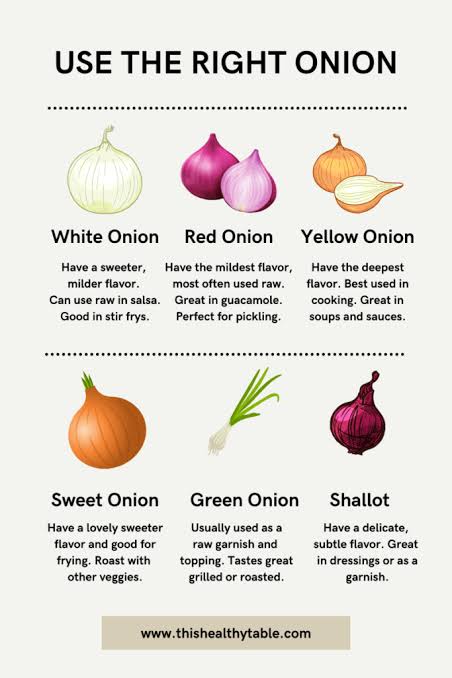
How well do you know your onions- Different types of onions, benefits and uses
Onions are a versatile and essential ingredient in many cuisines worldwide. They come in various types, each with unique flavors, benefits, and uses. Here’s a guide to the different types of onions and how to use them:
1. Yellow Onions
Meaning: Yellow onions are the most common type, known for their strong flavor and versatility. Benefits:
- High in antioxidants like quercetin, which may help reduce inflammation and lower blood pressure.
- Good source of vitamin C, fiber, and potassium. Uses:
- Ideal for soups, stews, and roasts.
- Perfect for caramelizing due to their high sugar content.
- Great as a base for stocks and sauces.
2. White Onions
Meaning: White onions have a milder flavor and a papery white skin. Benefits:
- Rich in vitamins and minerals, including vitamin C and calcium.
- Contain antioxidants that may boost immune function. Uses:
- Common in Mexican cuisine, such as in salsas and guacamole.
- Excellent for raw preparations like salads and sandwiches.
- Suitable for pickling due to their mild flavor.
3. Red Onions
Meaning: Red onions are known for their vibrant purple skin and slightly sweet flavor. Benefits:
- High in antioxidants, particularly anthocyanins, which may protect against heart disease and cancer.
- Contain sulfur compounds that have antibacterial properties. Uses:
- Best used raw in salads, burgers, and sandwiches.
- Adds color and flavor to salsas and relishes.
- Can be grilled or roasted for a milder flavor.
4. Sweet Onions
Meaning: Sweet onions, such as Vidalia or Walla Walla, are known for their high sugar content and mild taste. Benefits:
- Lower in sulfur, making them easier to digest for some people.
- Good source of vitamins A and C, which support immune health. Uses:
- Perfect for raw applications like salads and sandwiches.
- Great for making onion rings and caramelized onions.
- Suitable for roasting and grilling.
5. Shallots
Meaning: Shallots are small, elongated onions with a delicate, sweet flavor. Benefits:
- High in antioxidants and flavonoids, which may help reduce inflammation.
- Contain vitamins A, B6, and C, which are essential for overall health. Uses:
- Commonly used in vinaigrettes, sauces, and dressings.
- Excellent for sautéing and adding to gourmet dishes.
- Can be roasted whole for a sweet, caramelized flavor.
6. Green Onions (Scallions)
Meaning: Green onions are harvested young and have a milder flavor compared to mature onions. Benefits:
- Rich in vitamins A, C, and K, which support vision, immune function, and bone health.
- Contain antioxidants that may protect against chronic diseases. Uses:
- Ideal for garnishing soups, salads, and stir-fries.
- Adds flavor to omelets, tacos, and dips.
- Can be grilled or used in marinades.
7. Leeks
Meaning: Leeks are related to onions but have a milder, sweeter taste. Benefits:
- High in vitamins A and K, which are important for vision and blood clotting.
- Contain fiber that supports digestive health. Uses:
- Common in soups, particularly potato leek soup.
- Can be braised, sautéed, or grilled.
- Adds a subtle flavor to quiches and casseroles.
In conclusion, each type of onion brings its own unique flavor and nutritional benefits to the table. Understanding the differences can help you choose the right onion for your culinary needs, whether you’re looking to add a robust flavor to a stew, a mild crunch to a salad, or a sweet note to a roast. By incorporating a variety of onions into your cooking, you can enhance the taste and health benefits of your meals.